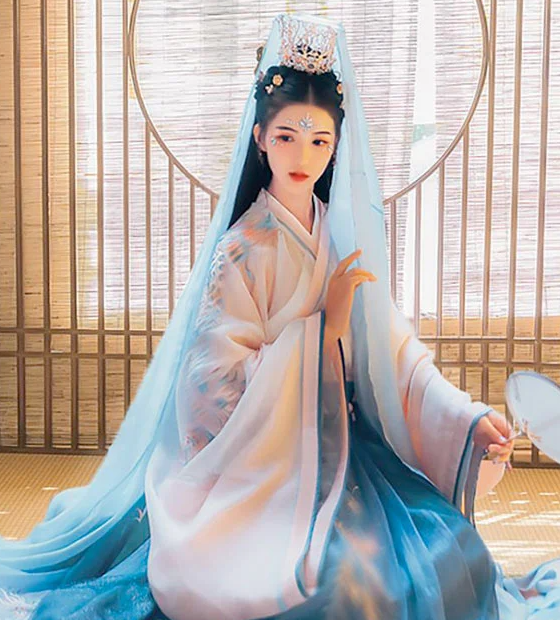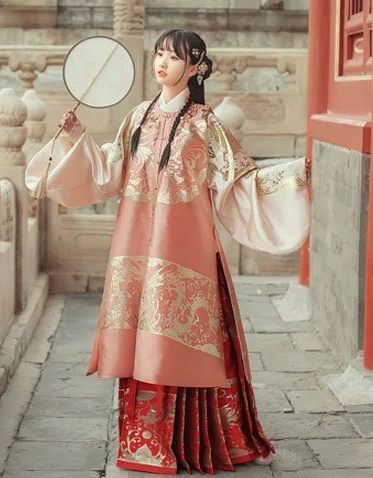The most popular clothing in China varies, from traditional Hanfu to modern streetwear influenced by pop culture.
Traditional Chinese Clothing
Hanfu: The Ancient Han Attire
Hanfu, which literally translates to “Han clothing”, represents the traditional clothing of the Han ethnic group, which is the majority ethnic group in China. It has a history that spans over 3,000 years and was predominant during the Han Dynasty.
Styles and Components of Hanfu
Different styles of Hanfu emerged over different dynastic periods, with some of the most iconic ones including:
- Shenyi: A wrap-around robe that was a popular choice during the Zhou, Qin, and Han dynasties.
- Ruqun: A combination of a top blouse and a skirt. It’s commonly associated with women’s attire during the Han dynasty.
Hanfu was made from a variety of materials, including silk, hemp, and cotton. The quality of silk, especially, was renowned for its soft texture and vibrant colors.

Qipao (Cheongsam): The Evolution and Popularity
The Qipao, often referred to as the Cheongsam outside of China, is a body-hugging dress. Its origins can be traced back to the Qing Dynasty, but its modern form became popular in the 1920s and 1930s in Shanghai.
Features and Variations of Qipao
While the traditional Qipao was long and loose, the modern version is more fitting. Common features include:
- High collar: This offers a graceful look and is a defining feature of the Qipao.
- Slits on the sides: This design was introduced for practicality and offers ease of movement.
Today, Qipaos are often made of high-quality silk with intricate embroidery designs, and they can cost anywhere from $100 to over $1,000, depending on the quality and design.
Tangzhuang: The Suit of the Tang Dynasty
The Tangzhuang is inspired by the clothing style of the Tang Dynasty, one of the most prosperous periods in Chinese history.
Characteristics of Tangzhuang
Some of the defining features of Tangzhuang include:
- Stand-up collar: Similar to the Qipao, the Tangzhuang often has a high collar.
- Frog buttons: These are a series of ornamental fastenings that give the Tangzhuang its distinct look.
Tangzhuang is often worn during special occasions, especially during the Lunar New Year. The cost of a Tangzhuang can range from $50 to $600, based on the material and craftsmanship.
Zhongshan Suit: The Influence of Modernization
Also known as the Mao suit internationally, the Zhongshan suit became a symbol of modern Chinese identity in the early 20th century.
Aspects of the Zhongshan Suit
Features of the Zhongshan suit include:
- Four pockets: Representing the Four Virtues – propriety, justice, honesty, and a sense of shame.
- Five center-front buttons: Symbolizing the Five Powers of the Constitution of the Republic of China.
Contemporary and Urban Fashion
The Rise of Chinese Street Fashion
China’s metropolises, from Shanghai to Beijing, have seen a significant rise in street fashion, largely driven by the younger generation. This movement is a blend of global trends with a unique Chinese twist.
Key Elements of Chinese Street Fashion
- Sneaker Culture: Sneakers have become an essential part of streetwear, with brands like Li-Ning making significant waves both locally and internationally. A pair of high-end sneakers can cost anywhere from $150 to $500.
- Oversized Clothing: Oversized T-shirts, hoodies, and jackets are trendy, emphasizing comfort while making a statement. The prices for these items can range from $30 to $300 depending on the brand and material quality.
- Accessories: Bucket hats, crossbody bags, and statement jewelry pieces play a crucial role in enhancing the street fashion look.
Popular Brands and Designers in Modern China
As China’s fashion scene continues to grow, numerous local brands and designers have made their mark both domestically and globally.
Leading Brands and Their Specialties
- Peacebird: Known for its youthful and trendy designs, Peacebird is a hit among the younger demographic. A typical Peacebird T-shirt can cost around $40.
- Ochirly: Catering primarily to women, Ochirly stands out for its sophisticated and modern designs. Dresses from Ochirly range from $60 to $200.
- Angel Chen: As a rising star in the fashion world, designer Angel Chen brings a fusion of traditional Chinese elements with modern aesthetics. Her creations can be on the pricier side, with some pieces exceeding $1,000.
Influences from Western and Other Asian Cultures
China’s urban fashion hasn’t developed in isolation; it has absorbed and reinterpreted influences from Western and other Asian countries.
Notable Influences
- Korean Pop Culture: With the meteoric rise of K-Pop and K-Dramas, Korean fashion, characterized by its minimalistic yet chic approach, has heavily influenced Chinese youth. Brands like StyleNanda have seen success in China with price points around $50 for a top.
- Japanese Minimalism: The understated and functional designs from Japan, epitomized by brands like MUJI and Uniqlo, have found a considerable following in China. For instance, a MUJI cotton shirt might be priced at around $40.
- Western High-Fashion: Luxury brands from Europe and the US, such as Gucci, Chanel, and Off-White, have gained immense popularity. A Gucci belt, for instance, can easily cost upwards of $350 in China.
Regional Variations
Clothing in Northern China
Northern China, characterized by its colder climate, has clothing styles that cater to the region’s brisk temperatures.
Distinctive Features of Northern Clothing
- Thick Fabrics: Wool and heavy cotton are frequently used materials. A woolen jacket in northern China might be priced around $80.
- Layered Clothing: Due to the cold, layered clothing is prevalent. This includes wearing multiple shirts or vests, often accompanied by long robes.
- Fur and Leather: Given the cold temperatures, fur-lined jackets and leather boots are common. A quality fur hat can cost upwards of $120 in local markets.
Clothing in Southern China
Southern China, with its warmer and more humid climate, has clothing adapted to these conditions.
Characteristics of Southern Attire
- Light Materials: Cotton and silk dominate the clothing landscape, offering breathability. A silk blouse, influenced by southern styles, might range around $50 to $150.
- Loose Fitting: The clothing is often looser, allowing for better air circulation, crucial for the humid environment.
- Bright Colors: The tropical environment sees a more vibrant color palette, with reds, yellows, and greens being prevalent.
Ethnic Minority Fashions
China is home to 56 ethnic groups, and while the Han Chinese are the majority, the various ethnic minorities have rich clothing traditions.
Prominent Ethnic Fashions
- Tibetan Clothing: Often made of wool, these outfits are bright and decorated with intricate patterns.
- Miao Clothing: Recognized for its exquisite embroidery and silver jewelry, Miao clothing is a feast for the eyes. A Miao skirt, with detailed hand-embroidery, can fetch prices upwards of $200.
- Uighur Attire: Influenced by Central Asia, Uighur clothing often features hats, long dresses, and robes. A traditional Uighur doppa, or hat, could cost around $30 to $60.
The Influence of Pop Culture
The Role of Chinese Cinema and TV in Fashion
Chinese cinema and television shows have always played a significant role in shaping the nation’s fashion trends, acting as a mirror reflecting societal changes and aspirations.
Film-Inspired Fashion
- Historical Dramas: Movies and series set in ancient dynasties often spark interest in traditional clothing like Hanfu.
- Modern Rom-Coms: Urban films showcase contemporary Chinese fashion, setting trends for young adults.
TV Shows and Reality Shows
- Variety Shows: Programs like “Keep Running” often have celebrities showcasing sporty and casual wear, influencing athletic fashion trends. A branded tracksuit similar to those worn on the show might range from $60 to $180.

Fashion Trends Driven by Celebrities
Celebrities, with their massive influence, often act as trendsetters, driving fashion fads across the country.
Celebrity Style Icons
- Fan Bingbing: Known for her impeccable style, both on and off the red carpet. Her love for elaborate gowns, priced upwards of $2,000, often sets a trend for gala fashion in China.
- Jackson Wang: His urban street style, combining high fashion with streetwear, resonates with the youth. His favored chunky sneakers can go for around $300-$500 a pair.
Brand Ambassadors
- Many luxury brands appoint Chinese celebrities as their ambassadors.
K-Pop, C-Pop, and their Influence on Chinese Youth Fashion
Music, especially from the pop genre, heavily impacts youth fashion, creating a blend of unique styles.
The K-Pop Influence
- Idol Fashion: K-Pop idols, with their distinct styles, influence Chinese youth. From oversized hoodies priced at around $70 to statement earrings for $20, their impact is palpable.
- Concert Merchandise: Fans often buy merchandise, including T-shirts ($40-$80) and caps ($20-$50), showcasing their allegiance to a particular group or artist.
The C-Pop Phenomenon
- Youth Icons: C-Pop stars like Cai Xukun and Kris Wu bring a mix of international and local fashion sense. Their influence often leads to certain clothing items, like bucket hats priced around $30 or uniquely styled jackets for $100, becoming trendy.